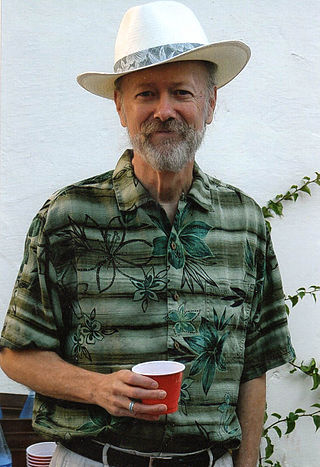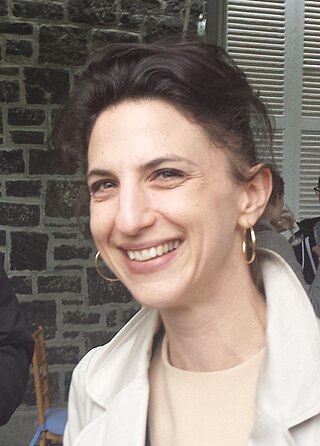Related Research Articles

Halteres are a pair of small club-shaped organs on the body of two orders of flying insects that provide information about body rotations during flight. Insects of the large order Diptera (flies) have halteres which evolved from a pair of ancestral hindwings, while males of the much smaller order Strepsiptera (stylops) have halteres which evolved from a pair of ancestral forewings.
Charles S. Zuker is a Chilean molecular geneticist and neurobiologist. Zuker is a Professor of Biochemistry & Molecular Biophysics and a Professor of Neuroscience at Columbia University. He has been an Investigator of the Howard Hughes Medical Institute since 1989.
Rachel Wilson is an American professor of neurobiology at Harvard Medical School and is a Howard Hughes Medical Institute Investigator. Wilson's work integrates electrophysiology, calcium imaging, molecular genetics, connectomics, computational modeling, and behavior to explore how neural circuits are organized to sense complex environments, learn associations between environmental features, and organize adaptive behavioral responses.

David J. Anderson is an American neurobiologist. He is a Howard Hughes Medical Institute investigator. His lab is located at the California Institute of Technology, where he currently holds the position of Seymour Benzer Professor of Biology, TianQiao and Chrissy Chen Leadership Chair and Director, TianQiao and Chrissy Chen Institute for Neuroscience. Anderson is a founding adviser of the Allen Institute for Brain Research, a non-profit research institute funded by the late Paul G. Allen, and spearheaded the Institute's early effort to generate a comprehensive map of gene expression in the mouse brain.
Christopher J. Chang is a professor of chemistry and of molecular and cell biology at the University of California, Berkeley, where he holds the Class of 1942 Chair. Chang is also a member of the Helen Wills Neuroscience Institute, a Howard Hughes Medical Institute investigator, adjunct professor of pharmaceutical chemistry at the University of California, San Francisco, and faculty scientist at the chemical sciences division of Lawrence Berkeley Lab. He is the recipient of several awards for his research in bioinorganic chemistry, molecular and chemical biology.
Michael B. Elowitz is a biologist and professor of Biology, Bioengineering, and Applied Physics at the California Institute of Technology, and investigator at the Howard Hughes Medical Institute. In 2007 he was the recipient of the Genius grant, better known as the MacArthur Fellows Program for the design of a synthetic gene regulatory network, the Repressilator, which helped initiate the field of synthetic biology. He was the first to show how inherently random effects, or 'noise', in gene expression could be detected and quantified in living cells, leading to a growing recognition of the many roles that noise plays in living cells. His work in Synthetic Biology and Noise represent two foundations of the field of Systems Biology. Since then, his laboratory has contributed to the development of synthetic biological circuits that perform a range of functions inside cells, and revealed biological circuit design principles underlying epigenetic memory, cell fate control, cell-cell communication, and multicellular behaviors.

Michael A. Marletta is an American biochemist. He was born in Rochester, New York, the son of Italian immigrants. He graduated from the State University of New York at Fredonia in 1973 with an A.B. degree in biology and chemistry, and from the University of California, San Francisco in 1978 with a Ph.D. degree in pharmaceutical chemistry, where he studied with George Kenyon. He was a postdoctoral fellow with Christopher T. Walsh at MIT from 1978-1980 and continued as a faculty member at MIT from 1980-1987 whereupon he joined the faculty of the University of Michigan, Ann Arbor. He was John G. Searle Professor of Medicinal Chemistry in the college of pharmacy and professor of biological chemistry at the University of Michigan. In 2001, he moved to the University of California, Berkeley to assume roles as Aldo DeBenedictis Distinguished Professor of Chemistry and professor of biochemistry and molecular biology, and served as the chair of the department of chemistry from 2005 until 2010. He was a Howard Hughes Medical Institute Investigator. From January 2012 to August 2014, Marletta was president and CEO of The Scripps Research Institute in La Jolla, California, succeeding Richard Lerner.

Michael Morris Rosbash is an American geneticist and chronobiologist. Rosbash is a professor and researcher at Brandeis University and investigator at the Howard Hughes Medical Institute. Rosbash's research group cloned the Drosophila period gene in 1984 and proposed the Transcription Translation Negative Feedback Loop for circadian clocks in 1990. In 1998, they discovered the cycle gene, clock gene, and cryptochrome photoreceptor in Drosophila through the use of forward genetics, by first identifying the phenotype of a mutant and then determining the genetics behind the mutation. Rosbash was elected to the National Academy of Sciences in 2003. Along with Michael W. Young and Jeffrey C. Hall, he was awarded the 2017 Nobel Prize in Physiology or Medicine "for their discoveries of molecular mechanisms controlling the circadian rhythm".
David Swenson Hogness was an American biochemist, geneticist, and developmental biologist and emeritus professor at the Stanford University School of Medicine in Stanford, California.

Paul H. Patterson was a neuroscientist and the Anne P. and Benjamin F. Biaggini Professor of Biological Sciences at the California Institute of Technology.

Pietro Perona is an Italian-American educator and computer scientist. He is the Allan E. Puckett Professor of Electrical Engineering and Computation and Neural Systems at the California Institute of Technology and director of the National Science Foundation Engineering Research Center in Neuromorphic Systems Engineering. He is known for his research in computer vision and is the director of the Caltech Computational Vision Group.

Marianne Bronner is a developmental biologist who currently serves as Edward B. Lewis Professor of Biology and an executive officer for Neurobiology at the California Institute of Technology. Her most notable work includes her research on the neural crest. Bronner's research focuses on studying the cellular events behind the migration, differentiation, and formation of neural crest cells. She currently directs her own laboratory at the California Institute of Technology called the Bronner Laboratory, and she has authored over 400 articles in her field.

Vanessa Julia Ruta is an American neuroscientist known for her work on the structure and function of chemosensory circuits underlying innate and learned behaviors in the fly Drosophila melanogaster. She is the Gabrielle H. Reem and Herbert J. Kayden Associate Professor and Head of the Laboratory of Neurophysiology and Behavior at The Rockefeller University and, as of 2021, an Investigator of the Howard Hughes Medical Institute.

Doris Ying Tsao is an American systems neuroscientist and professor of biology at the University of California, Berkeley. She was formerly on the faculty at the California Institute of Technology. She is recognized for pioneering the use of fMRI with single-unit electrophysiological recordings and for discovering the macaque face patch system for face perception. She is a Howard Hughes Medical Institute Investigator and the director of the T&C Chen Center for Systems Neuroscience. She won a MacArthur "Genius" fellowship in 2018. Tsao was elected a member of the National Academy of Sciences in 2020.

Nancy M. Bonini is an American neuroscientist and geneticist, best known for pioneering the use of Drosophila as a model organism to study neurodegeneration of the human brain. Using the Drosophila model approach, Bonini's laboratory has identified genes and pathways that are important in the development and progression of neurodegenerative diseases such as Amyotrophic lateral sclerosis, Alzheimer's disease, and Parkinson's disease, as well as aging, neural injury and regeneration, and response to environmental toxins.

Rob Brooks Phillips is an American biophysicist. He is currently Fred and Nancy Morris Professor of Biophysics, Biology, and Physics at the California Institute of Technology.
Mala Murthy is an American neuroscientist who serves as the Director of the Princeton Neuroscience Institute, and is the Karol and Marnie Marcin ’96 Professor of Neuroscience at Princeton University. Her work centers around how the brain extracts important information from the sensory world and utilises that information to modulate behavior in a social context. She is most known for her work in acoustic communication and song production in courting Drosophila fruit flies. Murthy and colleagues have also published an automated system for measuring animal pose in movies with one or more animal.

Pavan Ramdya is an American and Swiss neuroscientist and bioengineer. His research centers on understanding the cognitive and neuromechanical control of behavior toward applications in robotics and artificial intelligence. He holds the Firmenich Next Generation Chair in neuroscience and bioengineering at EPFL, and is head of the Neuroengineering Laboratory at EPFL's School of Life Sciences.
References
- ↑ "Michael H. Dickinson - www.bbe.caltech.edu". www.bbe.caltech.edu. Archived from the original on 2018-09-02. Retrieved 2015-07-17.
- ↑ "Dickinson Lab". dickinsonlab.caltech.edu.
- ↑ "Fly Guy". The Scientist Magazine®.
- ↑ "627: Dr. Michael Dickinson: Sorting Out the Science of Fruit Fly Flight and Behavior". People Behind the Science Podcast. 18 October 2021.
- ↑ "ICB | People". Archived from the original on 2010-06-25. Retrieved 2010-04-19.
- 1 2 Gorman, James (7 October 2013). "Focusing on Fruit Flies, Curiosity Takes Flight". The New York Times.
- ↑ "How flies fly - UChicago Medicine". www.uchospitals.edu.
- ↑ "Science Blog -- Michael Dickinson Named MacArthur Fellow". www.scienceblog.com.
- ↑ "Michael Dickinson | tedxcaltech.com". www.tedxcaltech.com.
- ↑ "Editor biographies". Archived from the original on 2015-08-15. Retrieved 2015-07-19.
- ↑ "NS&B History - Neural Systems and Behavior @ MBL". sites.google.com.
- ↑ "Michael Dickinson Named MacArthur Fellow". berkeley.edu.
- ↑ "Two Faculty Members Join American Academy of Arts and Sciences - Caltech". 30 April 2008.